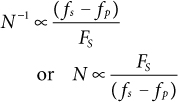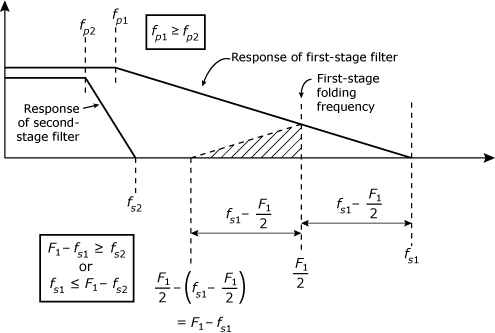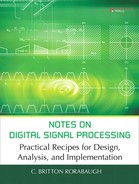Note 53. Multistage Decimators
When large reductions in sampling rates are required, the design of adequate decimation filters becomes more difficult, usually resulting in filters with a prohibitively large number of taps. This note introduces multistage decimators that accomplish large reductions in sampling rate as a sequence of several smaller reductions. In a properly designed multistage approach, the filters for all the stages have a total tap count that is significantly lower than the filter tap count needed to obtain similar performance from a single-stage implementation.
When the desired decimation factor, M, can be expressed as a product of I positive integer factors
M = M1 M2 ... MI
the desired decimation can be realized as a cascade of I decimators, each decimating by one of the factors, Mi. Compared to a single-stage decimator design, a design that adopts a multistage approach usually results in a reduced total computational burden, reduced memory usage, simpler filter designs, and reduced sensitivity to finite word-length effects in the implementation of the filters.
In lowpass FIR filter designs, the number of required taps, N, is approximately inversely proportional to the normalized transition bandwidth
53.1

where fp is the passband edge fequency in Hz, fs is the stopband edge frequency in Hz, and FS is the sampling rate in samples per second. To reduce N, we need either to decrease FS or to increase the difference between fs and fp. In a single-stage decimator we don’t have the freedom to make either change. However, in a two-stage decimator, there is some flexibility in the choice of the first-stage stopband edge frequency, fs1.
Figure 53.1 illustrates the important frequency relationships in a two-stage decimator design. The folding frequency of the first stage of the decimator is equal to half the sample rate, F1, at the first-stage output.
Figure 53.1. Crtical frequency relationships for a two-stage decimator

As shown in the figure, all frequency content above F1/2 remaining in the signal after the first-stage filter is aliased into frequencies below F1/2 once downsampling by M1 is performed. Frequencies from 0 to fS2 (which comprise the ultimate output spectrum) must be protected from aliasing. However, we do not care about aliasing in frequencies from fS2 up to F1/2, because all these frequencies will be removed by the second-stage filter. Therefore, to avoid aliasing of first-stage transition-band frequencies into the output of the second-stage decimator, the stopband edge for the first-stage filter, fS1, must be set to a value that does not exceed F1– fS2. Figure 53.2 shows the limiting case in which fP1 = fP2 and fS1 = F1– fS2.
Figure 53.2. Limiting case for critical frequency relationships for a two-stage decimator

The width of the transition band for the first-stage filter can be as wide as ΔF1 = F1– fS2 – fP2, which, in most cases, is significantly larger than the transition width of ΔF = fS – fP for a single-stage implementation. From Eq. (53.1), it is clear that a larger transition width results in a lower number of required taps.
For the second stage of a two-stage inplementation, the edges of the transition band are the same as they would be for a single-stage design:
fP2 = fP and fS2 = fS
Because the sample rate going into the second-stage filter has already been reduced by a factor of M1, that is, F2 = F1/M1, we can conclude from Eq. (53.1) that, except for changes to ripple specifications that may be needed due to multiple stages, the number of taps needed for the second stage can be approximated by
![]()
In most practical cases, N1 + N2 is significantly smaller than N.
Because a total of N multiplications would be needed in the single-stage design to generate each decimator output sample, the average required multiplication rate can be approximated as
53.2
![]()
In comparison, the average required multiplication rate for the two-stage design would be
53.3
![]()
A specific case of two-stage decimator design is provided in Example 53.1.
